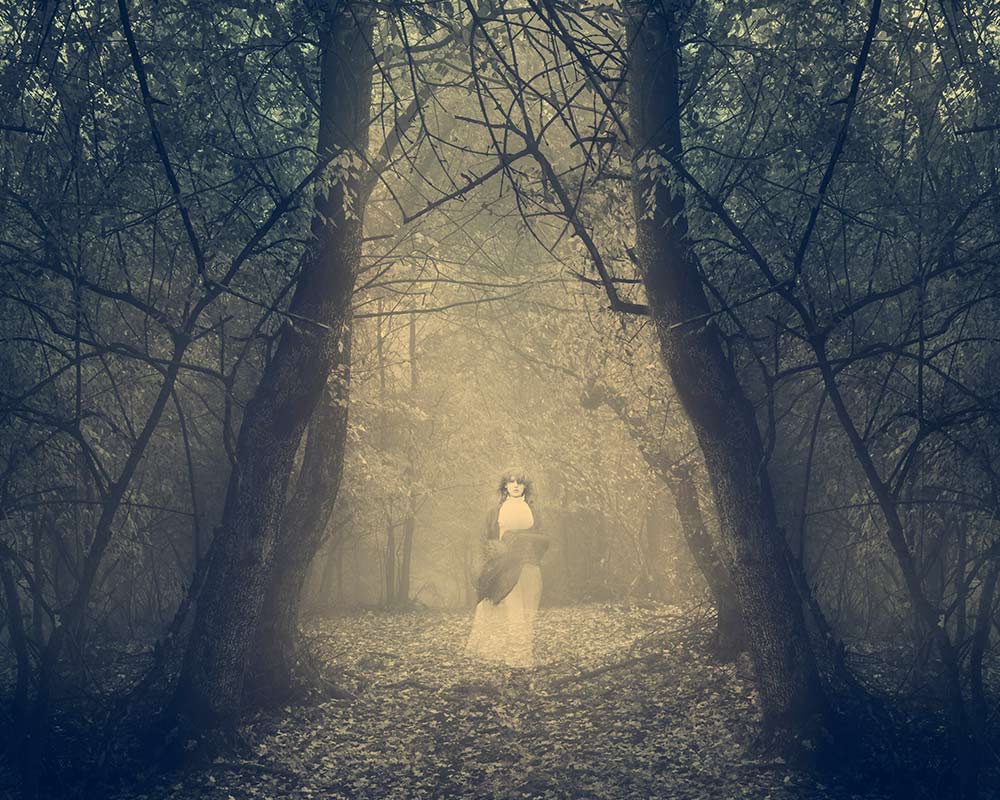Have you passed through Henpeck? How about Ostend or Barreville? Though some of these names may remain on maps, intersections, roads and other curious locations, few traces remain of these once-thriving settlements in our region.

Eber Norton traveled from Ohio in the early 1840s to settle on the prairies of northern Illinois. He followed the stagecoach trail and built a small clapboard home.
He was joined by homesteaders from Ohio, Massachusetts and New York. They christened their community Ostend, after a town in New York. The community of several hundred at one time boasted amenities like an inn, a post office, a creamery and its own cemetery.
And yet, by 1890 Ostend had disappeared from the map. It’s one of several “ghost towns” in the northwest suburbs – places that flourished for a time, only to vanish.
We typically associate ghost towns with the Old West, where you might still find traces of dusty saloons, mining towns and ramshackle wooden structures. Here in the Midwest, development has erased most traces of these ghost towns. But the past hangs on in concrete, visible ways as well as in memories and the historical record.
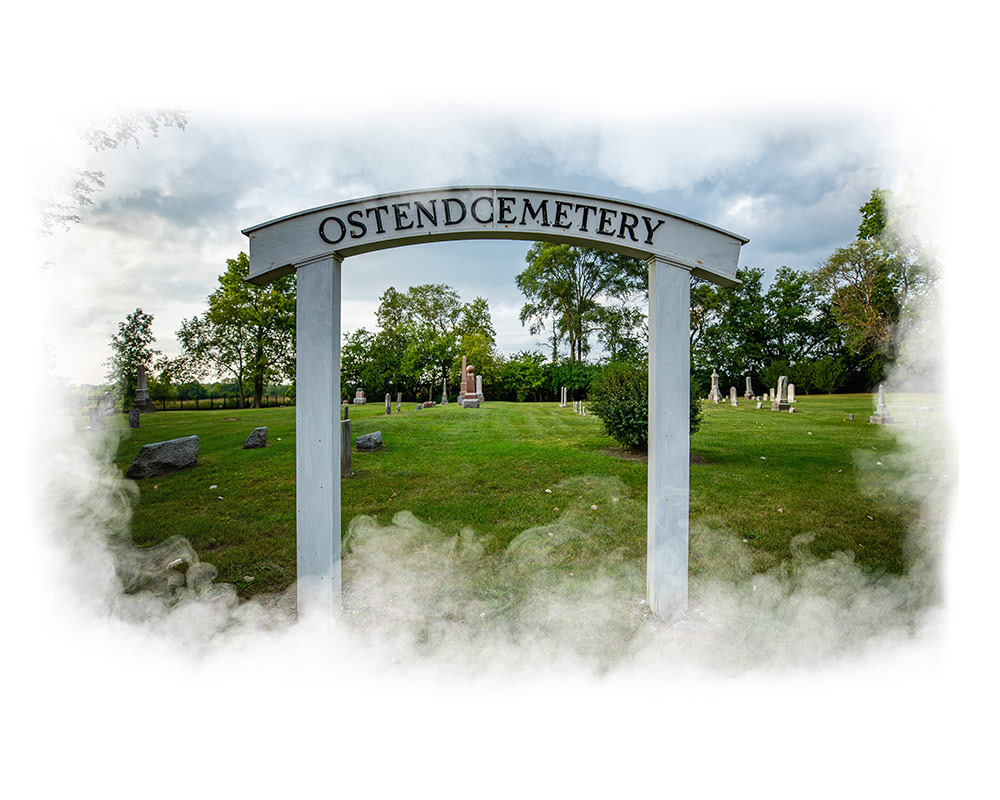
As for Ostend, Norton and many of his peers rest for eternity at peaceful, well-maintained Ostend Cemetery on Illinois Route 120. Just west of nearby Wonder Lake Drive, about 30 yards into the green overgrowth on the north side, there’s a cellar hole and the fieldstone foundations of Norton’s home.
We don’t need dusty saloons and tattered shacks to conjure the past. It’s all around us.
Henpeck
Before Hampshire, there was Henpeck.
Or, to put it another way, “Hampshire and Henpeck are generally synonymous,” says Susan Lye of the Kane County Genealogical Society.
In the 1830s, the stagecoach rumbled through what is now U.S. Route 20 and Big Timber Road. This crossroads took travelers from Chicago to Galena and Marengo to St. Charles. Bill Seymour set up shop at the crest of a hill. He sold oats and grain for the horses and swigs of alcohol to the wagon drivers.
A town grew up around Seymour.
“It was a wide-open town known for fun, for gambling, for drinking and carousing,” according to the late Bill Schmidt, a founder of the Hampshire Historical Society and the city’s mayor from 1985 to 2005.
The town’s unusual name may have come from the hens that followed the wagons and pecked at spilled grain, writes Schmidt. Another explanation sounds more like legend. “There was once a worthy lady living there who had such pronounced ideas as to women’s rights and asserted them so forcibly that the neighbors, seeing the henpecked condition of her husband, called the place ‘Henpeck.’ This name has remained as a monument to this martyred man,” wrote an unabashedly sarcastic Gertrude Hawley in an 1893 history contest that won her $10.
During the Civil War, the population swelled to more than 100. A gang of thieves called the Roughnecks held sway.
Eventually, more civilized behavior took root. Henpeck was “just a bunch of farmers,” says Orris Ruth, 80, who served for 30 years as a Hampshire trustee. His father and his eight siblings attended the one-room schoolhouse in Henpeck on Route 20. “He walked 3 miles to school each day,” says Ruth.
Henpeck faded in the 1870s when the new Chicago & Pacific line veered 3 miles southwest.
Hampshire was born there in 1876. Oddly, Henpeck remained on maps until around 2000, when it was literally wiped off the map.
Older folks still refer to the corner of Route 20 and Big Timber Road as Henpeck Corners. Down in Hampshire, on Illinois Route 72, Ruth helped to develop a lasting tribute: Henpeck Park.
Franklinville
Situated between Woodstock and Marengo is the remnant of Franklinville. Its current population is 38, according to the 2020 Census, which recognizes this area as a census designated place (CDP) – a “closely settled, unincorporated community locally recognized and identified by name.”
The hamlet started in 1835 with the arrival of the abrasive New Yorker George Albrow.
“He brought with him, besides his family and household goods, a crabbed disposition and a very disagreeable habit of snarling at everyone with whom he happened to have any controversy,” according to an 1885 county history.
His neighbors called him “Snarl Albrow” and his burgeoning community was dubbed Snarltown. Within a few years it was renamed Franklinville.
The community eventually had three stores, a blacksmith shop, a Methodist church and a hardscrabble school.
Franklinville gained a post office in 1843; water-powered grist and sawmills were opened three years later by the three Smith brothers from Scotland. But the town’s pride was its cheese factory, erected in 1868.
Franklinville withered away in the late 19th century when the railroad went to Woodstock. Though most of this settlement has disappeared, one noteworthy piece remains. In 1884, revered Civil War veteran Andrew Lasell raised money for a new town hall at the corner of Franklinville and Garden Valley Roads. The land cost $150 and materials cost $100.
The quaint frame building became the home of McHenry Historical Society in 1996 and was renamed Perkins Hall in honor of the society’s president. Not a soul argued in favor of Snarl Hall.
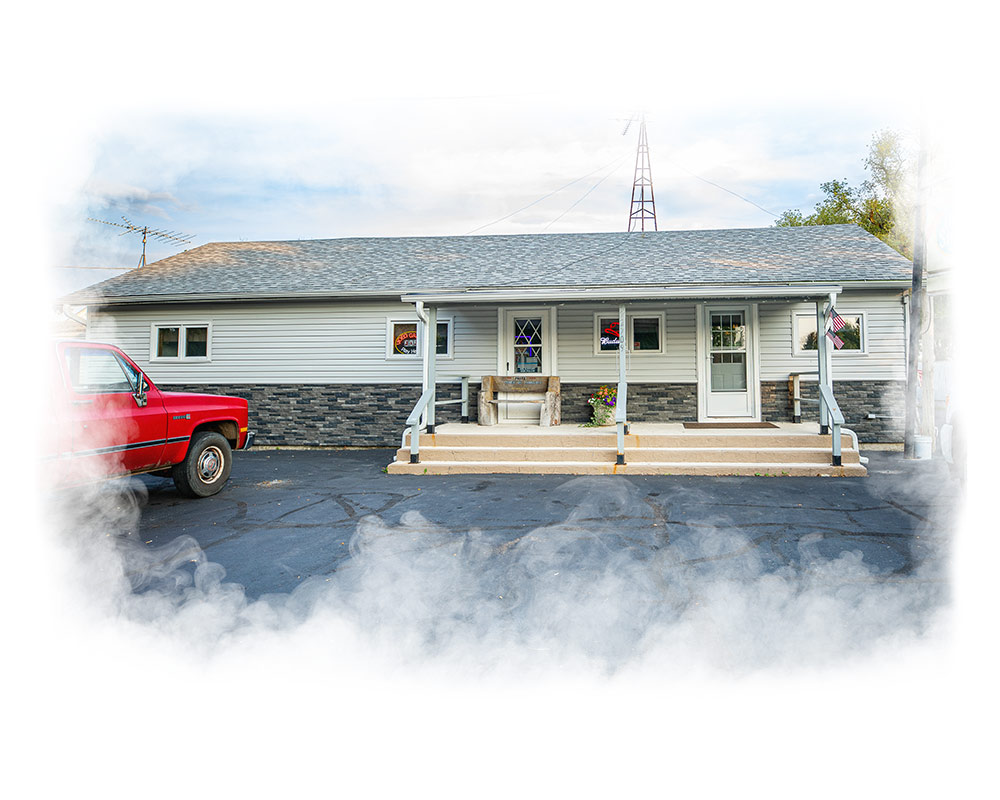
Lawrence
Pioneers carved civilization out of wilderness, arriving in a “prairie schooner drawn by oxen,” according to a 1908 history of Kane County. Their food staples were rye bread and corn bread.
Their clothing was homemade. So were the candles.
“Of pictures, books and the evidences of culture, taste and refinement common to the modern home the settlers possessed little or nothing,” according to the history. “Their largest asset was sterling character and courage that might meet all obstacles and overcome them.”
Despite this strong character, vice sometimes undid the best efforts. Natural calamities sealed many more fates. Lawrence suffered them both.
Ambitious Lawrence Bigsby used an 1847 land grant to build a home and village around the Chicago & North Western railroad near present-day Lawrence and Oak Grove roads in northeast McHenry County.
Along with a general store, blacksmith shop, hotel, tavern and other businesses there was the prestigious Lawrence Academy, a rare brick school. Railroad authorities took note and planned to build a roundhouse and maintenance shop there.
When word got out, speculators bought up land. “These landowners not only defeated the company but also themselves,” according to a McHenry County history.
A few miles south, cagey landowner Elbridge Ayer, a Massachusetts native, told the railroad, “I have all the land you need.” Ayer named his village after his hometown, Harvard.
Lawrence was well into decline when, on May 18, 1883, a powerful tornado destroyed most of its buildings.
Today, Lawrence is a CDP with a population of 220. Its most tangible reminder is the House of Lawrence, a bar and grill on Oak Grove Road that opened in 1949.
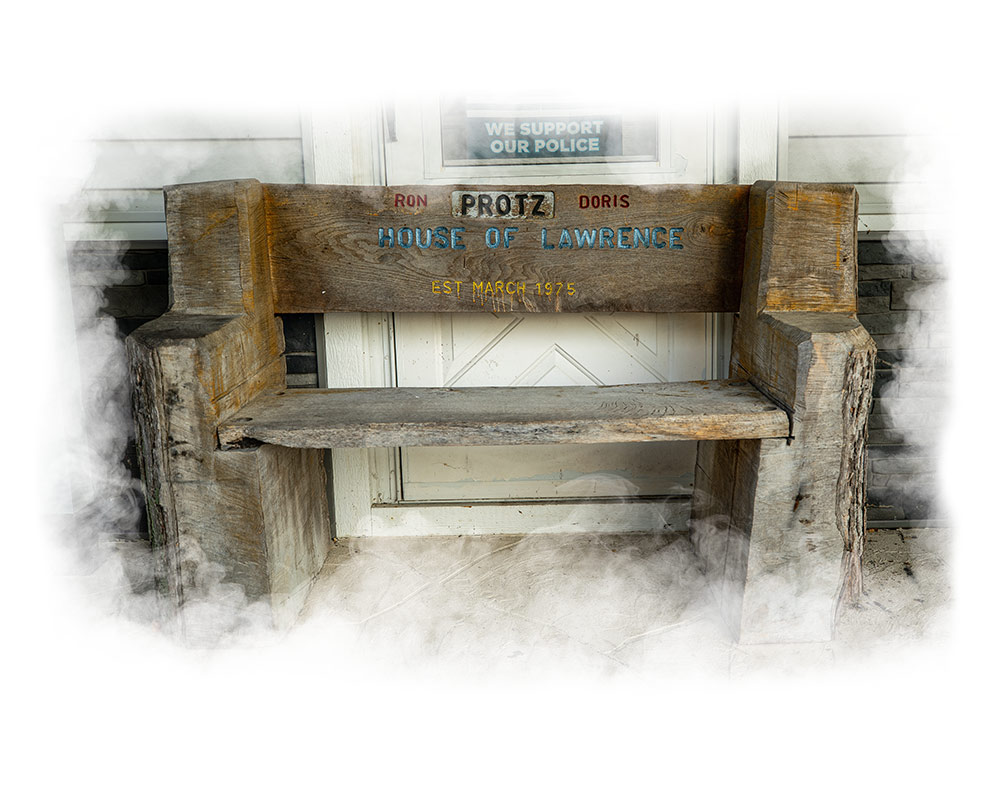
A married couple who said they lived in Lawrence once frequented the bar. “They moved to Arizona,” says Ron Protz, the owner since 1975. He says Lawrence Bigsby’s grave is nearby, partially obscured in the Nan-Chris Heights subdivision. “It’s kind of up on a hill. My kids found it once,” he says.
The pace of life is reminiscent of bygone days. His home is close to his pub: “44 steps away.” And things remain the same nearby. “Not a lot of change around here,” he says.
Most oddly, history repeats itself. Or tries to. A tornado ripped through the area in 2008 and flipped a locomotive near the pub. That train saved the pub, Protz says. “It pushed the tornado up, and it bypassed us.”
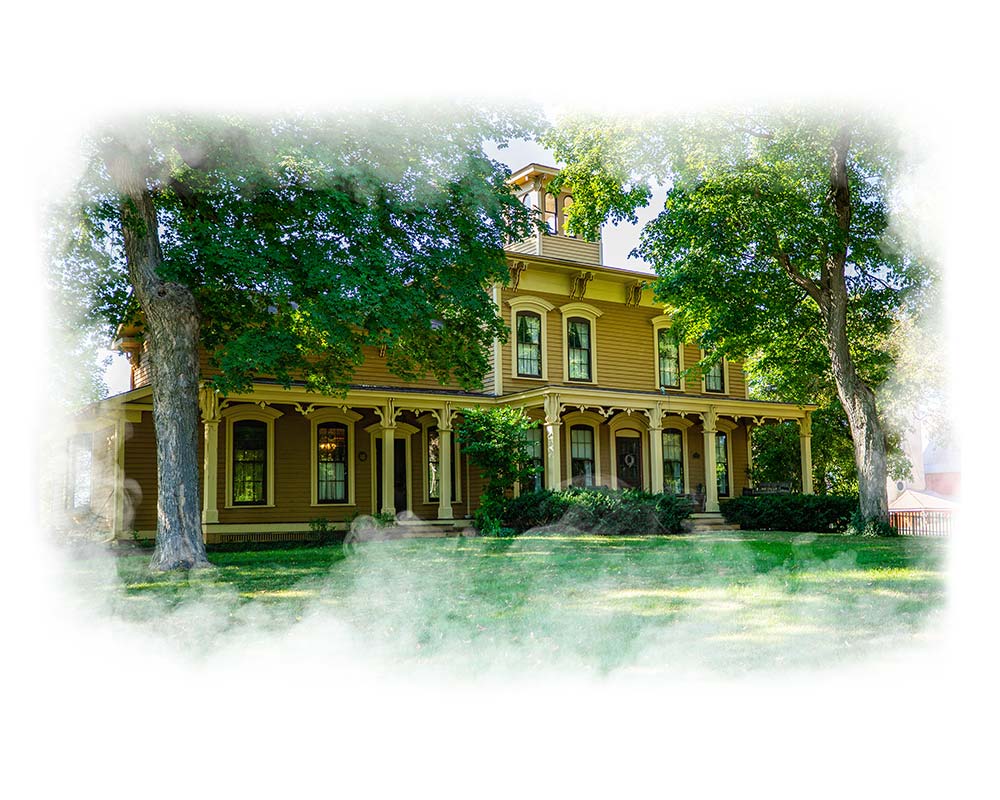
Bald Mound
When a small pocket of settlers put down roots around 1850 in an area 5 miles west of Batavia, the only significant geographic feature was a treeless hill. So, the community near the current intersection of Bliss and Kaneville roads became known as Bald Mound.
The enclave consisted of a post office, a schoolhouse and not much else. Except for the stunning Stearns-Wadsworth house. Farmer Stearns was the largest landholder in Blackberry Township by 1868 when he built the two-story, Italianate-style mansion. Edgar Wadsworth purchased it in 1885 and used it partly as a creamery. It also was used for church services.
Today, the home is privately owned. In 1982 it was added to the National Register of Historic Places, whose files note its chief claim to fame: an example of a 19th-century residence in “the germ of a town that never happened.”

Brookdale
Founded by families from Ireland, Brookdale was built and abandoned, all within in eight years.
John Quinlan was born in County Cork and settled along the Kishwaukee River in the late 1830s near present-day Woodstock. Later came the Goggins, Duggans, Lawlers and Sullivans. They had settled in Chicago and dug the Illinois and Michigan Canal. Their next backbreaking project was to help build a railroad from Chicago to Janesville, Wis., according to local historian Craig Pfannkuche.
Part of the challenge was to carve into a hill northeast of Brookdale.
The Irish got little credit for their hard work but they did gain notoriety for carousing. “Verbal histories tell of a wide-open village which had nine saloons and not many more houses,” noted the Woodstock Sentinel in 1940.
The rail line actually undermined the town. The stagecoach route that ran through Brookdale was instantly outmoded, and the sawmills that cut timber for the railroad became idle. So, the Irish improvised. In the 1860s, they disassembled most of the town and repurposed its timber into farmhouses.
The town hall survived into the 1940s as part of Brookdale Farm before finding a new life thanks to industrial artist Elmer Pelegrin. He used original beams for his large brick home and incorporated an arched doorway and black oak boards.
The property changed hands a few times before 2000, when it became the administrative center of the McHenry County Conservation District. The office sits in Brookdale Conservation Area, a nod to the past and its preservation.
Barreville
Nestled along a stream west of Crystal Lake, this burg began ignominiously. Its first settler in the 1850s, Thomas Combs, feuded with newcomer Thomas Ferguson and torched Ferguson’s home. He escaped while in custody.
Ferguson then built a three-story grist mill for $6,000. Spring-fed Stickney Run Creek was dammed to provide power. Before long, stores, a flour mill, a pickle factory and two cheese factories crowded the intersection of what’s now Nish and Barreville roads.
A milk and cheese operation run by Eugene and Mary Matthews was particularly successful. By 1883, the couple produced 5,000 pounds of milk daily.
Sullivan Shepard opened the pickle factory after surviving the Guntown battle in the Civil War. Actually, Shepard missed the fighting. He was in the hospital suffering from the “effects of an insect in his ear,” says Pfannkuche.
Barreville was a happening place. “Quite an exciting little town, Barreville,” opined the Nunda Herald in 1883. “Some of the residents make it so by shooting cats, chickens and carriage top covers and other things of interest.”
Alas, the excitement petered out when the railroad veered north in the 1850s.
Barreville was swallowed into Prairie Grove, yet remnants remain. Older homes from the 19th century sit near Barreville and Nash roads. Parts of the dam and building foundations exist in the scrub.
There are other reminders, as well. A board member of the Crystal Lake Historical Society is Pat Paul, whose great-grandfather was a cheese whiz: Eugene Matthews.
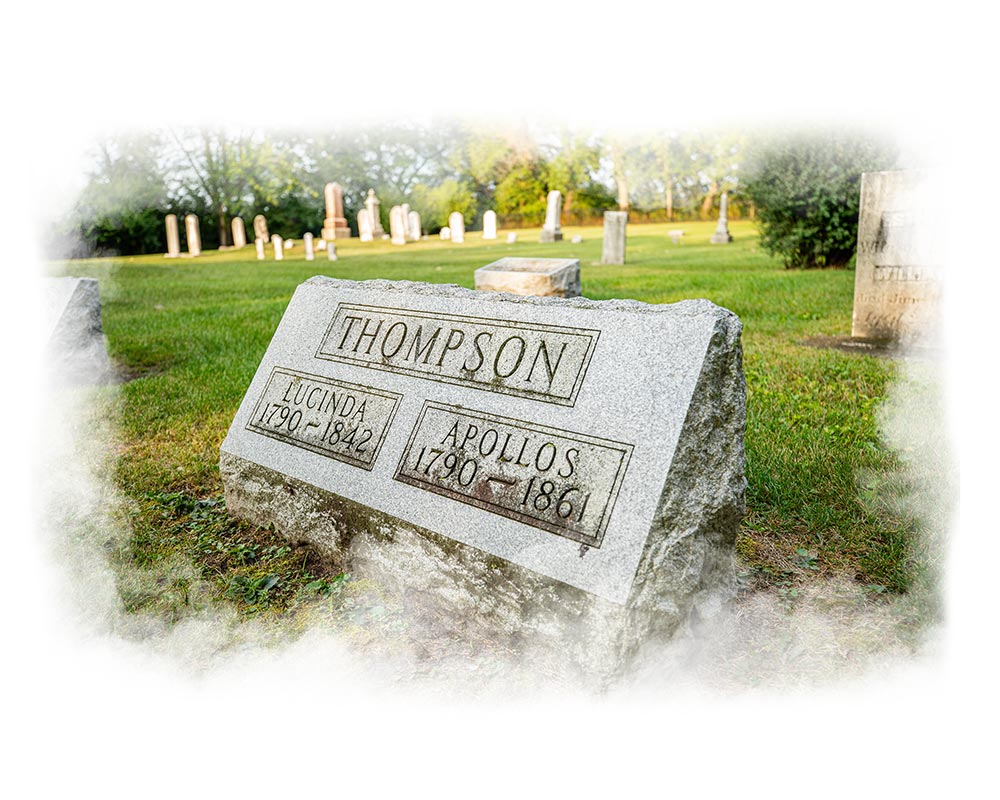
Ostend
Neatly groomed Ostend Cemetery occupies a single acre off Ill. Rt. 120. Its weathered grave markers hide lifetimes of stories, tales of hardships, livelihoods established and families rooted.
Appollos Thompson set aside the land to bury his wife, Lucinda. They had moved from Vermont in 1842. Lucinda, after nursing her sick daughter back to health, apparently contracted the same illness and died in late 1842. She was 52. Appollos died in 1861 at age 71. He lies alongside Lucinda.
The place was originally called Thompson Burial Grounds and was later known as Overocker Cemetery, apparently a reference to a young couple who frequently visited the graveyard, rocking with grief at the death of their child.
The cemetery was part of a historical tour once led by Pfannkuche and Kurt Begalka, former administrator of the McHenry County Historical Society and Museum.
“It’s a cool place to visit,” says Begalka. “It’s a tangible representation of the people who lived here long ago.”
Railroads doomed Ostend in the 1850s when two bypassed the town, first the Fox River Valley Railroad, which favored Elgin, and then the Chicago, St. Paul and Fond du Lac Railroad, which boosted Woodstock.
The selection of Woodstock as the county seat also hurt Ostend, says Pfannkuche. So, too, did human miscalculation. The settlement’s small creek was too meager to turn a mill wheel. Some Ostend pioneers relocated toward Nippersink Creek in Greenwood, which still exists.
The Lingering Past
“Ghost town” implies vanishing or emptiness, but it can also evoke a spirit, something not seen but still present. The past and the present keep colliding in the northwest suburbs. For more than 30 years, until the 2000s, Everett Thomas oversaw the Ostend cemetery’s maintenance. His great-grandfather, Andrew, staked out 80 acres in 1840. His farm adjoined the Thompson property.
Among the graves he kept neat were those of five Thomases.
Begalka, for one, is all for keeping the past alive.
“We overlook the past,” he says. “Take away our smartphones and how smart are we? These people who came before us were pretty smart. They carved out a living.”


















































